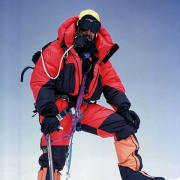Gaping Crevasses and Sheet Ice Stall Progress on Annapurna

Climbing Season Underway in the Himalayas
Expeditions to the Himalayas have begun as spring welcomes more accommodating weather to climb the world’s highest peaks. The weather window has just opened as the jet stream makes its annual northern pilgrimage into Tibet, which allows mountaineers to pursue these towering peaks. The climbing expeditions working on early attempts on Annapurna have met resistance due to difficult conditions on the 8,000-meter peak.
Fourteen mountains in the world rise above 8,000 meters (26,247 feet). These mountains reside in Asia's Himalayan and Karakorum mountain ranges and reach into the rarefied and dangerous strata known as the Death Zone. Legendary Italian climber Reinhold Messner became the first to summit these prestigious mountains in 1986. His historic feat, chased by ambitious mountaineers ever since, set the high water mark in mountaineering.
French climbers Louis Lachenal and Maurice Herzog were the first mountaineers in the world to summit an 8,000-meter peak - Annapurna I in 1950, three years before Sir Edmund Hillary and Tenzing Norgay scaled Mt. Everest for the first time.
Annapurna
Annapurna I, the 10th highest mountain in the world, stands 8,091 meters (26,545 feet) in the Himalayas of Nepal. Its name, derived from Sanskrit, means "Goddess of the Harvests," symbolizing abundance. Despite its name, Annapurna's slopes are unforgiving and dangerous. The mountain's fatality-to-summit ratio of over 30% makes it among the most feared climbs in mountaineering.
Climbing Begins on Annapurna
Teams on Annapurna recently began preparations for the early spring climbing season in the Himalayas. Annapurna's routes are highly avalanche-prone, especially in early spring, but this early spring has been challenging. It was reported in ExplorersWeb, a team of Sherpas set sections of the season’s first route on Annapurna in preparation for expeditions arriving throughout the spring. The Sherpas of Imagine Nepal, the company in charge of setting up the ropes for Annapurna this spring, have worked to fix ropes to the mountain’s summit.
The move to the higher camps on Annapurna presents the most dangerous sections of the climb due to the high risk of avalanches and steep climbing among overhanging seracs. The head of Imagine Nepal, Mingma G, expressed that this section concerns the climbers most.
Current Situation on Annapurna
This season’s primary concern centers around untypical exposed crevasses due to a lack of snowpack after an extremely dry winter, which makes the Sherpas’ efforts more difficult and dangerous. The Sherpa team had to abort their efforts near 25,000 feet as they ran out of rope. “We had a very difficult time on Annapurna,” Imagine Nepal’s Mingma G told ExplorersWeb from Base Camp. “I have never seen the mountain in such bad conditions.”
While the lack of snow reduces avalanche risk, it marginalizes the climbing faces to sheer ice. This makes setting a route around huge crevasses and imposing seracs difficult, and requires more rope to navigate an unfamiliar route
“It took us two days to find a way through the icefall right above Camp 3,” Mingma G said. “Our team reached 7,600m, tackling many A-shaped crevasses, [but at that point,] they had to abort the summit because of lack of rope. We will try again, and we won’t miss the summit this time,” Mingma G said.
The 8,000-Meter Peaks
Mount Everest (8,848m / 29,029 feet); K2 (8,611m / 28,251 feet); Kangchenjunga (8,586m / 28,169 feet); Lhotse (8,516m / 27,940 feet); Makalu (8,485m / 27,840 feet); Cho Oyu (8,188m / 26,867 feet); Dhaulagiri (8,167m / 26,795 feet); Manaslu (8,163m / 26,781 feet); Nanga Parbat (8,126m / 26,660 feet); Annapurna (8,091m / 26,545 feet); Gasherbrum I (8,080m / 26,509 feet); Broad Peak (8,051m / 26,414 feet); Gasherbrum II (8,035m / 26,362 feet); Shishapangma (8,027m / 26,335 feet).
